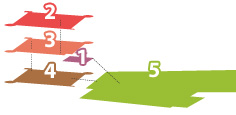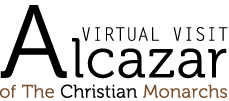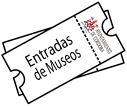
Drawing room (1 of 2) Audiodescription.

You are now in the Drawing Room which has a square floor plan. This little room, closed off to the public and adjacent to the Salón de Mosaicos (Hall of Mosaics), contains choir stalls carved from walnut of the 15th chapter choir which belonged to the ancient town council, with an illustration of the collaciones or parish of Córdoba. The symbols and shields which were carved onto the backs of the armchairs survive to this day.
The room also houses la mesa the mapa de los descubrimientos, which occupies the centre of the room, a table featuring maps of the new lands discovered by the Spanish, other works of great artistic significance and a highly valuable nineteenth century bureau that can be found in the corner, to the right of the entrance. The centrepiece at the end of the room is a Roman mosaic depicting the ocean exhibited in the front of he room.
There are also two sculptures. The head of the Great Captain, in marble, an original piece, located in the top of the map table , which depicts the same image as the equestrian sculpture located at the centre of Tendillas Square in Córdoba; and the bust of González Fernández de Córdoba, the "Great Captain", located on the corner to the right of the access door , an original work by sculptor, painter and architect Federico Amutio y Amil (1869-1942) dating from1908. The artist was awarded third prize in the Fine Arts Exhibitions of 1890 and 1892, as well as the third medal in 1901 in Decorative Art. He also received an honourable mention in 1895 in architecture.
Sections of this piece:
Press the Play buttons to access a speech version of the description or the audiodescription for visually impaired.
Click in Audiodescription to access to its text version.

Alcazar of the Christian Monarchs. Plaza Campo Santo de los Mártires s/n. 14004 Córdoba
2011 Ayto. de Córdoba. All rights reserved. Legal Advice


